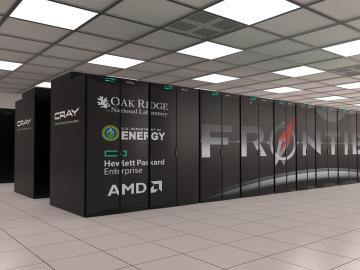
Filter News
Area of Research
- (-) National Security (45)
- (-) Nuclear Science and Technology (27)
- (-) Supercomputing (153)
- Advanced Manufacturing (5)
- Biological Systems (1)
- Biology and Environment (102)
- Biology and Soft Matter (4)
- Building Technologies (2)
- Chemical and Engineering Materials (3)
- Chemistry and Physics at Interfaces (7)
- Clean Energy (168)
- Climate and Environmental Systems (7)
- Computational Biology (1)
- Computational Chemistry (5)
- Computational Engineering (1)
- Computer Science (3)
- Data (1)
- Earth Sciences (1)
- Electricity and Smart Grid (1)
- Energy Frontier Research Centers (7)
- Fuel Cycle Science and Technology (2)
- Functional Materials for Energy (8)
- Fusion and Fission (32)
- Fusion Energy (7)
- Geographic Information Science and Technology (1)
- Isotopes (21)
- Materials (122)
- Materials for Computing (13)
- Materials Synthesis from Atoms to Systems (8)
- Materials Under Extremes (7)
- Neutron Data Analysis and Visualization (2)
- Neutron Science (72)
- Quantum Condensed Matter (3)
- Quantum information Science (4)
- Renewable Energy (2)
- Sensors and Controls (2)
- Transportation Systems (4)
News Type
News Topics
- 3-D Printing/Advanced Manufacturing (5)
- Advanced Reactors (4)
- Artificial Intelligence (25)
- Big Data (15)
- Bioenergy (4)
- Biology (8)
- Biomedical (7)
- Biotechnology (2)
- Buildings (2)
- Chemical Sciences (1)
- Climate Change (15)
- Computer Science (49)
- Coronavirus (8)
- Cybersecurity (8)
- Decarbonization (4)
- Energy Storage (1)
- Environment (16)
- Exascale Computing (12)
- Frontier (13)
- Fusion (6)
- Grid (4)
- High-Performance Computing (22)
- Isotopes (2)
- Machine Learning (13)
- Materials (5)
- Materials Science (11)
- Mathematics (1)
- Microscopy (2)
- Molten Salt (1)
- Nanotechnology (5)
- National Security (23)
- Net Zero (1)
- Neutron Science (7)
- Nuclear Energy (19)
- Physics (4)
- Quantum Computing (10)
- Quantum Science (11)
- Security (6)
- Simulation (10)
- Software (1)
- Space Exploration (2)
- Summit (21)
- Sustainable Energy (3)
- Transformational Challenge Reactor (2)
- Transportation (3)
Media Contacts

It’s a simple premise: To truly improve the health, safety, and security of human beings, you must first understand where those individuals are.

ORNL researchers used the nation’s fastest supercomputer to map the molecular vibrations of an important but little-studied uranium compound produced during the nuclear fuel cycle for results that could lead to a cleaner, safer world.

A team of researchers has developed a novel, machine learning–based technique to explore and identify relationships among medical concepts using electronic health record data across multiple healthcare providers.

A study led by researchers at ORNL could help make materials design as customizable as point-and-click.

Tackling the climate crisis and achieving an equitable clean energy future are among the biggest challenges of our time.

Lawrence Berkeley National Laboratory physicists Christian Bauer, Marat Freytsis and Benjamin Nachman have leveraged an IBM Q quantum computer through the Oak Ridge Leadership Computing Facility’s Quantum Computing User Program to capture part of a

Unequal access to modern infrastructure is a feature of growing cities, according to a study published this week in the Proceedings of the National Academy of Sciences

ORNL scientists had a problem mapping the genomes of bacteria to better understand the origins of their physical traits and improve their function for bioenergy production.

Computational users at the Oak Ridge Leadership Computing Facility, or OLCF, are running scientific codes on Frontier’s architecture in the form of a powerful test system at the OLCF called Crusher.

A study by researchers at the ORNL takes a fresh look at what could become the first step toward a new generation of solar batteries.


